Samuel G. Freedman. Into the Bright Sunshine: Young Hubert Humphrey and the Fight for Civil Rights. New York: Oxford University Press, 2023. 488pp
A biography only of the first half of the life of Hubert Humphrey, this book also gives us brief glimpses into the inner workings of the administrations of Franklin Roosevelt and Harry Truman, as well as a highly selective history of the city of Minneapolis. The result is a curious mix of truncated biography and narrowly defined political/urban history that ultimately raises as many questions as it seeks to answer.
For the time being, however, Samuel Freedman is content to provide answers, all of which are both forcefully stated and unmistakable. It is his contention that serious problems of racial and ethnic discrimination, problems exacerbated by the impact of the Great Depression on people of all races and ethnicities, demanded the serious attention of government at all levels, but especially at the federal level.
Preoccupied with the economic problems created by the depression, and burdened by the powerful southern wing of the Democratic Party, the Roosevelt administration of the 1930s was never able to give significant attention to the plight and needs of African Americans. Then came World War II. That war raised the conscience of Americans north and south, east and west, white and black and otherwise. This was so, both because the fight was against a racist Nazi Germany and because the fight itself laid bare the far less deadly, but nonetheless discriminatory, racism here at home.
Left to deal with a conscious-raised America, the Truman administration edged its way toward tackling some issues relating to matters of racism at home. Desegregating the military was an important first step. But it was far from the only step that needed to be taken.
In fact, action was underway on many fronts by many individuals. Baseball was finally desegregated in 1947 when Jackie Robinson made his debut as a Brooklyn Dodger, thereby ending what conservative columnist and Minneapolis native Westbrook Pegler called the “craziest wrong in America.” Robinson himself was an outspoken Republican, as was Dodger general manager Branch Rickey who engineered the breaking of the color line in major league baseball.
By and large, the leaders of this growing national campaign for civil rights for black Americans, coupled with an end to segregation and discrimination, were northern liberals of both major parties. Nationally, one of the key leaders was Iowa’s Henry Wallace, the Roosevelt vice-president whom Truman had replaced on the national ticket in 1944. Opposing the Wallace wing of the party were powerful and entrenched southern senators and congressmen, who represented the still solidly Democratic south.
Caught in the middle of all this were President Harry Truman of Missouri and his septuagenarian vice-president, Alben Barkley of Kentucky. In author Samuel Freedman’s estimation, neither was as interested in — or as committed to — advancing black civil rights and in healing the country’s racial divide as he should have been. As the campaign and election of 1948 approached, the field was open for a rising generation of younger new leaders.
Enter the mayor of Minneapolis, Minnesota. That would be a barely 37-year-old Hubert Humphrey, who was then preparing his run for national office. As of 1948 no Minnesota Democrat, let alone any DFLer, had ever been elected to the United States Senate. Humphrey was about to be the first. But before he could take on Republican incumbent Senator Joseph Ball, Humphrey took on the Democratic Party establishment at its national convention in Philadelphia over the suddenly, if belatedly, crucial issue of civil rights.
The climax of this book deals with that convention and Humphrey’s surprisingly crucial role in it. And the climax of that climax is the Humphrey speech that provides Freedman with the title of his book, specifically the mayor’s call for his party to get out of the “shadow of states’ rights” and walk in the “bright sunshine” of civil rights.
This is the same Hubert Humphrey that his friend and ally, Arthur Naftalin, later the first Jewish mayor of Minneapolis, perhaps affectionately, but perhaps not, characterized as a “windbag.” Freedman begs to differ. At least he takes great pains to make sure that his readers understand that Hubert Humphrey was much more than that. Here he succeeds admirably.
Born in 1911, this son of a struggling South Dakota druggist came of age during the height of the Great Depression. Hard hit by the double whammy of a terrible economy and drought, the Humphrey family moved frequently and barely survived, but survive they did. Victimized by bad times and bad luck, none saw themselves as victims.
Hubert Horatio Humphrey, Sr., otherwise known simply as “H.H.,” had had political ambitions of his own and in fact would hold a number of minor posts in the Democratic Party of South Dakota. The father wanted his namesake to work for and with him, which the youthful HHH did. But the father also recognized his son’s ambitions and his abilities in the larger arena of politics.
Educated in fits and starts at the University of Minnesota, the younger triple H would forever remain close to his father, who would die a few months after his son’s 1948 speech and successful election to the Senate from the neighboring state of Minnesota. At the U of M, his mentor was a political science professor by the name of Evon Kirkpatrick, later the husband of Jeanne Kirkpatrick who one day would be President Ronald Reagan’s ambassador to the United Nations.
Initially anticipating a career as a college teacher, Humphrey obtained a master’s degree in political science at Louisiana State University, where he had his first direct experience with the racial caste system and enforced legal segregation. Upon returning to the Twin Cities to teach briefly at Macalester College and later work for various New Deal agencies, Humphrey soon became quite aware that racial issues and racial discrimination were not confined to the American south.
By this point Humphrey was also happily married to Muriel Buck. Money was always a problem for the young couple, especially when three children were quickly added to the mix. Service in World War II was blocked for a number of reasons, initially because of a variety of physical issues, but ultimately because of his family obligations. According to another friend and ally, Orville Freeman, later a two-term DFL governor, Humphrey was “just literally crying” over his inability to enter the military.
Remaining on the home front, Humphrey continued to hold a number of local posts in federal agencies before running and losing his first race for mayor of Minneapolis in 1943. Undaunted and unbowed, he won a rematch with the incumbent mayor in 1945 and was re-elected in 1947. The stage was set for bigger things.
A young man of obvious political talent, keen ambition and genuine passion, Hubert Humphrey was ready for the national political stage. The issues were clear, and his slate was clean. There were no skeletons to be found in any Humphrey closet.
Interspersed with chapters on the Humphrey story are chapters dealing with the treatment of blacks and Jews in the city of Minneapolis. Those stories center on de facto discrimination against both, whether it be a matter of jobs, schools, or housing. Scattered here and there are accounts of mob actions on the part of whites against blacks, as well as human interest tales of black victims of racial injustice.
Two individuals of great importance to Humphrey figure prominently in Freedman’s accounting. One is Cecil Newman, black editor of the Minneapolis Spokesman; the other is Sam Scheiner, local attorney, jazz authority on WDGY, and director of the Minneapolis Anti-Defamation council. Both chronicled and combatted the discriminatory treatment of blacks and Jews of the city. Both were key Humphrey allies.
Freedman makes a solid case for the legitimacy and the effectiveness of Hubert Humphrey as a politician and a civil rights champion. An engaged leader and never a demagogic one, Humphrey’s concerns were always rooted in solving real problems, problems which he either faced or understood or both. At the same time, it must be acknowledged that one of those problems was political, specifically the remaking of the Democratic Party into something very much other than the party of slavery and Jim Crow segregation.
In that regard, Freedman briefly, if almost off-handedly, notes Humphrey’s role in purging the merged Democratic Farmer-Labor Party of its pro-communist, Popular Front elements. The brevity and off-handedness of that acknowledgement seems to suggest that, in Freedman’s judgment, the importance of this Humphrey effort deserves to be de-emphasized. But is that really the case?
Clearly, the left wing of the Minnesota Farmer-Labor Party, as well as the Communist Party of America (CPA), had emphasized this issue before and during World War II. Come 1948, Mayor Hubert Humphrey wanted this issue not simply to be a DFL and national Democratic Party priority, but an issue of supreme importance and prominence. Which is precisely what the soon-to-be Senator Humphrey succeeded in accomplishing.
There is little doubt that it was important to Humphrey that his party reverse the course of its long history as the pre-Civil War party of slavery and the post-Civil War party of Jim Crow. There is also little doubt that he succeeded in doing just that.
To be sure, all of this was done for both moral reasons and political reasons. Actually, the gradual shift of black voters from the Republican to the Democratic Party had begun during the New Deal. That shift continued and solidified during and after World War II. Today, by and large, the black voter remains a loyal Democrat.
Freedman assumes that this will be the case forever more. Taking his story only to 1948, he does include an epilogue, titled “The Unfinished Task,” which offers brief word portraits of Humphrey’s role in the passage of the Civil Rights Act of 1964 and the Voting Rights Act of 1965, even as he neglects to mention that a greater percentage of Republicans than Democrats voted for this legislation.
Instead, in the same epilogue he takes time to make mention of current flashpoints in America’s “unending civil war.” One of them was Minneapolis in 2020. Another was the Charlottesville violence of 2017. Here Donald Trump makes his first appearance. In responding to the latter, Trump “equated the white supremacists with the antiracists, telling reporters that there were ‘very fine people on both sides.’” Whether intentionally or not, Freedman fails to mention what has long been conceded, namely that Trump was referring to the debate over statue removal, and not to the battle in the streets of Charlottesville.
Not content to stop there, Freedman proceeds to contrast Humphrey’s “transformation of Minneapolis from a national example of bigotry into a beacon of progress against discrimination” with Trump as “both the beneficiary and the architect of a reactionary coalition of Christian nationalists and unreconstructed racists,” many of whom would be the ideological descendants of the Christian nationalists and unreconstructed racists who had opposed Humphrey.
Freedman then wonders about the future. What next? Will “shadows and dust storms triumph over bright sunshine in the end?” Freedman is confident that sunshine will prevail. At least that will be the case so long as the Hubert Humphreys of America triumph over the Donald Trumps.
But other questions do remain to be asked. Among them is this: What might Hubert Humphrey think and do today? Here it is 2023. We are nearly as far away from 1948 as a 37-year-old HHH was from the Civil War. If Humphrey sought to make sure that his Democratic Party was a far cry from the Democratic Party of slavery and Jim Crow, the Democratic Party of today is a far cry from the Democratic Party of his early political career.
The issues are different as well. Once again, questions remain. Vice-President Humphrey’s boss, Lyndon Johnson, presumed that blacks would become a permanent part of a new Democratic coalition, thanks to his Great Society and the passage of historic civil rights and voting rights legislation. But is that permanence coming to an end?

Humphrey believed that black and white Americans — and all Americans — wanted the same things. For starters, they wanted strong families, good schools and safe streets. Would he still support a welfare system that has such a devastating impact on black family life, especially a fatherless life for too many black children?
Conservative economist Milton Friedman often liked to remind us that it could often prove to be a “great mistake” to “judge policies and programs by their intentions rather than their results.” Humphrey’s intentions were invariably admirable. But have the results across the board been equal to those intentions?
Another conservative economist, Thomas Sowell, has contended — and demonstrated — that considerable black economic progress was taking place before the passage of the historic civil rights legislation of the mid-1960s. Conversely, that very economic progress advanced more slowly after the mid-1960s. Once made aware of that, would a Hubert Humphrey have second thoughts and/or different ideas and solutions?
Would a Hubert Humphrey be at home in a Democratic Party that seems to be as preoccupied with skin color as were John C. Calhoun and a young George Wallace? Would he worry that today’s Democratic Party once again threatens to be the party of segregation by endorsing segregated dormitories and segregated graduations?
Would Humphrey revel in identity politics or oppose this reversion to tribalism? Would he stand with or against those who call for a color blind America? Would he applaud affirmative action and quota systems or “eat” the bill page by page as he promised to do, if the Civil Rights Act opened the door to anything like that?
For that matter, would he support defunding the police? Would he sit still while Minneapolis burned? And perhaps most importantly, would he champion school choice? Or would he again sit back, content to be as beholden to teachers unions as his party is today?
Who knows the answer to any of these questions? But they are nonetheless fair to ask — and to wonder about — as we await the next generation of ambitious, young political leaders, black, white and otherwise, who we hope will be as committed to tackling real problems as a youthful Hubert Horatio Humphrey was.

















